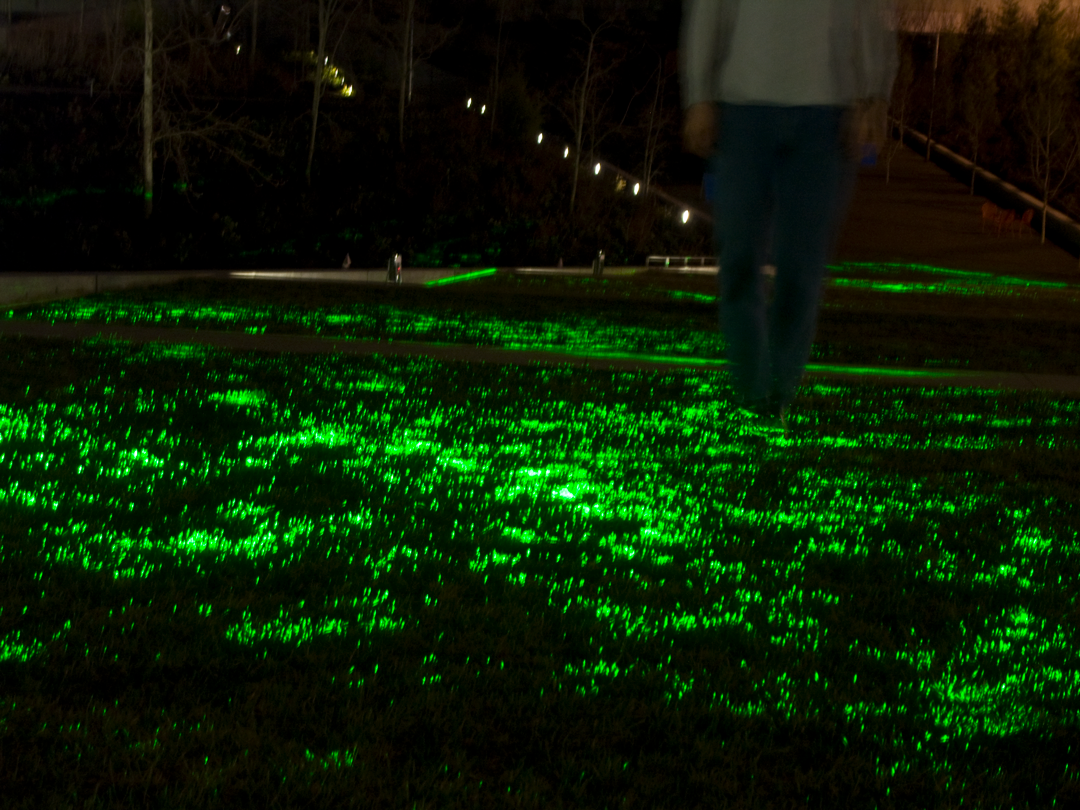After 10 Years, the Grass Keeps Getting Greener
We’re celebrating the Olympic Sculpture Park turning 10 with a laser show! Installed for this year’s SAM Lights on December 15, Greener by Iole Alessandrini and Ed Mannery is an art installation made from light that was originally on view at the grand opening of the park in 2007. Missed SAM Lights? Not to worry! Greener will light up the terrace through January 16.
In the 10 years since the laser grid of Greener cast SAM visitor’s in its net, artist Alessandrini has had some time to reflect on the light sculpture, her practice, and what it means for an artwork and a sculpture park to interact and create visual connections for visitors. A Seattle transplant from Italy, Alessandrini began her Laser Project Series with Optical Engineer Ed Mannery in 2001 during a residency at Bellevue Art Museum. As Iole Alessandrini has had said of her work, “It is the intersection between these two creative expressions—art and architecture—” through which her work moves. At the Olympic Sculpture Park, Greener covers over 2,500 square feet of grass in the Gates Amphitheater between Richard Serra’s Wake and the PACCAR Pavilion.
See this work in the twilight hour between sunset and park closure for optimal viewing!
SAM: How does nature factor into your focus on architecture and design?
Iole Alessandrini: Since early studies on light-art at the University of Washington (1996), I have been captured by the symbiotic and antithetic relationship between natural and artificial light. Symbiotic—in that natural and artificial light make things visible; antithetic—as the sun dominates over artificial light. Within enclosed spaces the laser of our installations is free from sun’s interference and it appears radiant. In outdoor environments, the light from both the sun and the laser interplay with each other in a symbiotic and antithetic way. This unique interplay manifests when the sun sets and the sky darkens. During this transition, the light from the art prevails to become visible in itself, while revealing the natural landscape surrounding people.
What about the interplay between the tangible and intangible interests you and drives your work?
I think of light as a medium that I can model, shape and bend. Perhaps as one who shapes clay; I shape light. The singular wave-behavior of laser, which directs the rays to move parallel to each other, gives the laser-light the distinctive shape of a beam. In the presence of dust or smoke the light-beam becomes visible yet intangible.
With the installation Greener, Optical Engineer Ed Mannery and I used cone optics to direct the beam to form a plane. It is the nature of light to be evident when objects reflect it. In the park, the light-planes intersecting the grass-blades reveal this natural phenomenon and look as if they are lit from within. Both grass and light are evident yet the light remains intangible.
Is movement crucial to all your light-based works? I’m thinking of something like “Three of Us” which captures movement through laser projections as compared to Greener which inspires movement through laser projections.
Many of our projects involve a direct connection with viewer and light. The Three of Us is a photo of a unique phenomenon of light captured with the camera as people move through the laser-planes. The project Untitled at Jack Straw Production (2004) provided us the first opportunity to document this phenomenon. I photographed a woman’s hands as she moved them back and forth rapidly through the plane. This picture created the series which I titled Shroud as it shows a flat subject taking on a ghostly aspect through the interface with the light plane. The photos are unique as they resemble holograms and they are of great interest to me. I am an avid researcher of motion in photography as seen in the work by Eadweard Muybridge, Jules Etienne Marey and Harold Edgerton.
How is Greener activated by the interaction of park visitors?
Contemplating the work from a distance vs. interacting with it—as in immersing oneself in the light—are distinctive ways in which Greener can be experienced. Yesterday at the park during its opening, we observed that dynamic at play. In both cases it was satisfying to witness the sense of wonder and engagement coming from people staring at and interacting with 2,500 square feet of light under their feet. Greener visually connects different aspects of the Olympic Sculpture Park, from Serra’s Wake to the PACCAR Pavilion causing visitors to walk and step over the grass and the light of our installation.
Do you see Greener differently after the last 10 years? What does the passage of time lend to the work and it’s relationship to the park?
We were pleased to see that even after 10 years the technology continues to work. It works in function, and it works in keeping visitors engaged and mesmerized. Their appreciation of the art, the landscape, and the architecture speaks volumes, making Greener an aesthetic expression and synthesis of them all.
–Chelsea Werner-Jatzke, Copywriter/Content Strategist
